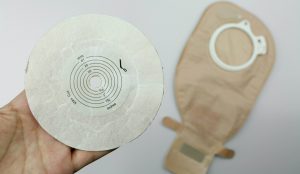For those who use a stoma bag – or colostomy bag – there is often embarrassment when it comes to using the bathroom. The stereotypes about what kind of people have them and the reasons for having to use one are often unkind and inaccurate. In reality, a broad range of people use a stoma bag for different reasons. To challenge the stigma directed at those with a stoma, greater visibility is being shone on those who don’t fit the image of a typical ostomate.
What is a Stoma Bag?
A stoma bag is a medical device that is placed on the outside of the body that collects diverted food waste. It’s used to help manage conditions that effect the regularity and efficiency of the digestive system. Some of the conditions that may benefit from – or even require – the use of a stoma bag are:
- Crohn’s disease
- Diverticulitis
- Bowel, colon, anal, or rectal cancer
- Vaginal or cervical cancer
- Bowel incontinence
- Hirschsprung’s disease.
The bag works by diverting the colon out of a surgically created opening – known as a stoma – and attaching it to the external bag. This bag can then be emptied when full, or in some cases it can re-enter the body and pass waste through the rectum as normal, essentially bypassing the faulty part of the digestive system. Both of these can be temporary or permanent.
How Does a Stoma Bag Effect a Person’s Lifestyle?
The assumption by many is that a stoma bag is inconvenient and restrictive when it comes to retaining an ‘ordinary’ lifestyle. However, the idea that they can stop a person from enjoying certain foods and activities is only partly true. During the early stages, where there is still recovery and adjustments to be made, a patient may have to stop doing and eating certain things as instructed by their doctor. Nevertheless, once things have settled and healed the versatility of the bag exceeds many expectations.
Many people with digestive conditions choose to have a stoma bag fitted in order to improve convenience. Most significantly, it removes the anxiety of always needing to know where nearest toilet is in case of sudden digestive episodes. A stoma bag provides a level of insurance that can reduce the likelihood of an embarrassing or unpleasant moment caused by the individual’s particular digestive condition. After adjusting to living with a stoma many patient’s daily lives are less impacted by their condition that they were without one.
In addition to the piece of m ind a stoma bag provides, the modernisation of the procedure and equipment has made them discreet and unrestrictive. There’s perhaps no better example of this than in the case of Michelle Willcocks. Despite suffering from ulcerative colitis and becoming ill – resulting in the fitting of a stoma bag – Michelle continued with her active lifestyle. The bags restrictions were so negligible that Michelle could continue to take part in her sport of triathlon and eventually become a world champion in the sport.
ind a stoma bag provides, the modernisation of the procedure and equipment has made them discreet and unrestrictive. There’s perhaps no better example of this than in the case of Michelle Willcocks. Despite suffering from ulcerative colitis and becoming ill – resulting in the fitting of a stoma bag – Michelle continued with her active lifestyle. The bags restrictions were so negligible that Michelle could continue to take part in her sport of triathlon and eventually become a world champion in the sport.
Michelle’s case is just one example of many that shows how living with a stoma bag doesn’t need to signal the end of an active a fulfilling life. In reality, it can improve the situation for those who have digestive conditions that restrict their freedom.